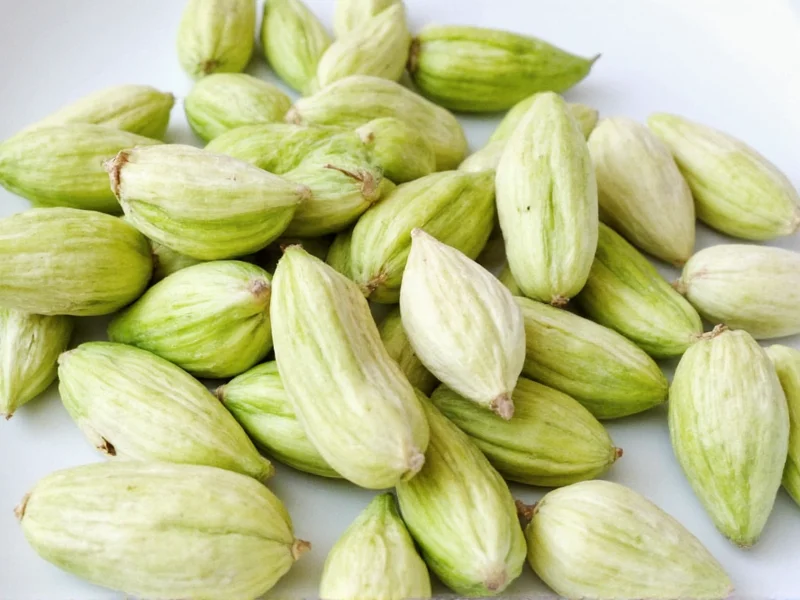Cardamom pods represent one of the world's most valuable spices by weight, second only to saffron and vanilla. These distinctive triangular capsules grow on perennial plants native to India's Western Ghats region, though cultivation has expanded to Guatemala, Sri Lanka, and Tanzania. The pods develop from delicate white flowers with violet lower lips, maturing over several months before harvest.
Physical Characteristics of Cardamom Pods
Cardamom pods feature a thin, fibrous outer shell that ranges in color from pale green to dark brown depending on variety and processing. Each pod contains 8-16 black or dark brown seeds arranged in double rows. The pods measure approximately 1-2 centimeters in length and 0.5-1 centimeter in width, with a distinctive triangular cross-section that helps distinguish them from similar-looking pods.
| Cardamom Type | Pod Color | Size | Flavor Profile |
|---|---|---|---|
| Green Cardamom | Pale to medium green | 1-1.5 cm | Citrusy, floral, eucalyptus notes |
| Black Cardamom | Dark brown to black | 2-3 cm | Smoky, camphorous, menthol notes |
| Madagascar Cardamom | Light green | 1.5-2 cm | Earthy, citrus, pine notes |
Green vs. Black Cardamom Pods: Understanding the Difference
While both green and black cardamom pods belong to the Zingiberaceae family, they come from different genera and serve distinct culinary purposes. Green cardamom pods (Elettaria cardamomum) grow in moist, shady environments and are typically dried naturally without heat exposure, preserving their delicate flavor compounds. Black cardamom pods (Amomum subulatum) undergo smoke-drying over open fires, which imparts their characteristic smoky aroma.
Chefs working with authentic Indian recipes often specify which type to use, as substituting green for black cardamom can dramatically alter a dish's flavor profile. Green cardamom pods work well in sweet applications like Scandinavian pastries and Middle Eastern coffee, while black cardamom pods enhance savory dishes like biryanis and meat stews.
How to Use Cardamom Pods in Cooking
Understanding how to use cardamom pods properly makes a significant difference in culinary results. Professional chefs recommend these techniques:
- Whole pod infusion: Add entire pods to rice dishes, soups, or stews during cooking, then remove before serving
- Seed extraction: Gently crush pods to release seeds for grinding or direct addition to recipes
- Dry roasting: Briefly toast whole pods in a dry pan to intensify flavor before use
- Infused liquids: Steep pods in milk, cream, or simple syrup for desserts and beverages
When substituting for ground cardamom, remember that one cardamom pod typically contains enough seeds to equal 1/6 teaspoon of ground spice. For optimal flavor, many professional kitchens prefer using whole pods rather than pre-ground cardamom, which loses potency quickly.
Proper Storage of Cardamom Pods
To maintain maximum flavor and shelf life, store cardamom pods in airtight containers away from light and heat. Whole pods retain their aromatic compounds significantly longer than ground cardamom—typically 12-18 months when properly stored compared to 6 months for ground spice.
Check for freshness by gently squeezing a pod; fresh cardamom should release a strong, pleasant aroma and feel slightly springy. Avoid pods that feel brittle or fail to release fragrance, as these have likely lost their essential oils and flavor compounds.
Culinary Applications Around the World
Cardamom pods feature prominently in global cuisines with remarkable versatility. In Scandinavian baking, green cardamom pods flavor traditional breads like Finnish pulla and Swedish kardemummabullar. Indian cuisine uses both green and black varieties extensively—green in desserts like kheer and black in savory dishes like garam masala.
Middle Eastern coffee traditions often include a single green cardamom pod crushed into the grounds before brewing, while Arabic qahwa typically features multiple pods for a more pronounced flavor. In Southeast Asia, cardamom pods appear in curry pastes and meat marinades, contributing complex aromatic notes.
Health Benefits and Traditional Uses
Traditional medicine systems have utilized cardamom pods for centuries. Ayurvedic practitioners commonly recommend chewing cardamom pods to freshen breath and aid digestion. Modern research suggests cardamom contains compounds with potential antioxidant and anti-inflammatory properties, though more clinical studies are needed to confirm specific health benefits.
When exploring cardamom pod benefits for digestion, many cultures prepare a simple tea by crushing 2-3 pods and steeping them in hot water for 5-10 minutes. This traditional preparation remains popular across India, the Middle East, and Scandinavia as a digestive aid after meals.
Economic Importance and Sustainability
Cardamom represents a vital cash crop for smallholder farmers in India and Guatemala, which now produces more cardamom than India. Sustainable harvesting practices have become increasingly important as demand grows. Unlike many spices, cardamom plants require specific shade conditions and take 2-3 years to reach full production, making sustainable farming practices essential for long-term viability.
Consumers seeking ethically sourced cardamom pods should look for certifications indicating sustainable farming practices, as wild harvesting has threatened some native cardamom populations in India's Western Ghats region.











 浙公网安备
33010002000092号
浙公网安备
33010002000092号 浙B2-20120091-4
浙B2-20120091-4